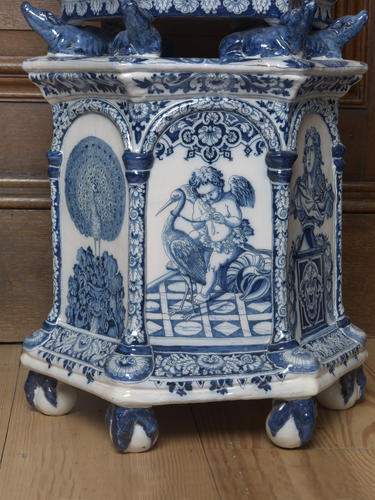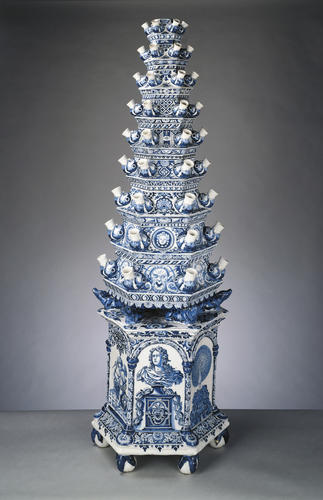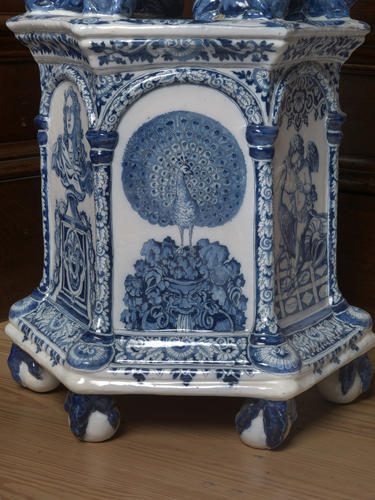-
1 of 253523 objects
Pair of tulip vases c.1694
Tin-glazed earthenware | 147.2 cm (whole object) | RCIN 1085

Adriaen Kocks (d. 1701)
Master: Pair of tulip vases Item: Tulip vase c.1694



-
A set of two tin-glazed earthenware bulb vases. On hexagonal base stands a tall steeple-like hexagonal pyramid built of nine detachable storeys, on six seated buffalo. Each story with six bulb-cups. Base handpainted in underglaze blue with panels of peacocks, bust and cupid-with-stork.
Many of Queen Mary II's Delft vases are described in the inventories of her palaces at Het Loo and Hampton Court as standing on the hearth. Flower vases such as these were used to ornament the fireplace during the spring and summer when fires were not lit. Each of the nine hexagonal stages was made separately, with a sealed water reservoir and six protruding grotesque animal mouths, into which the cut stems of tulips or other flowers could be placed. There may originally have been a pointed finial or stopper in the top of each vase. The lowest stage is attached to the backs of six recumbent cows placed at the angles of the hexagonal base. Two sides of the base are painted with a youthful bust of William III; two have a winged putto seated on an overturned ewer, holding a lead which is attached by a collar to a standing stork; the remaining two have a peacock displaying its tail plumage and standing on a rocky fountain ornamented with shells, suggestive of a garden grotto.
The forms and ornaments of these and similar vases are distinctly playful; the six tiers of a hexagonal pyramid at Williamsburg, for example, rest on the backs of snails. A pyramid vase of this general design and bearing the mark of Adriaen Kocks is at Chatsworth House; a pair of square examples painted in the base with architectural capricci, and another pair of the same shape with allegorical figures, are at Dyrham Park in Gloucestershire. Delft vases which formerly belonged to William and Mary survive in other collections, the most important being an orange-tree pot at Erddig in Clwyd which bears the royal arms and cypher.
Catalogue entry from Royal Treasures, A Golden Jubilee Celebration, London 2002Provenance
Acquired by Queen Mary II prior to her death in 1694.
-
Creator(s)
(manufacturer)(manufacturer)Acquirer(s)
-
Medium and techniques
Tin-glazed earthenware
Measurements
147.2 cm (whole object)
Category
Place of Production
Delft [Netherlands]